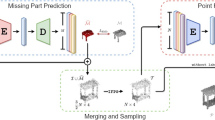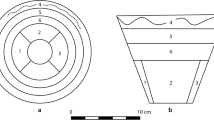Abstract
A great deal of time, patience, and effort are required to excavate pottery. For example, archaeologists dig hundreds to thousands of pottery shards from an excavation site. However, restoring pottery is a time-consuming and challenging process, requiring considerable amounts of expertise, experience, and time. Therefore, computer-assisted restoration methods are indispensable to assist the pottery restoration process. However, existing restoration approaches mostly resort to heuristic-based approaches, which are computationally expensive to match and align different shards together. It is often infeasible to handle and process a large number of shards to reconstruct pottery in 3D. In this paper, we propose a deep learning-based pottery restoration algorithm to classify a pottery shard to a specific pottery type and further predict the exact shard location in the pottery type. We use a novel 3D Convolutional Neural Networks and Skip-dense layers to achieve these objectives. Our model first processes a 3D point cloud data of each shard and predicts the shape of the pottery, which a shard possibly belongs to. We first apply Dynamic Graph CNN to effectively perform learning on 3D point clouds of shards and use Skip-dense layers for a classifier. In particular, we generate features from the 3D scanned point cloud of each shard using spatial transform and edge convolution, then classify shards into one of the pottery shape types using Skip-dense. We achieve 98.4% of classification accuracy over 5 different pottery types and 0.032 RMSE for shard location prediction.
Access this chapter
Tax calculation will be finalised at checkout
Purchases are for personal use only
Similar content being viewed by others
References
Computational analysis of archaeological ceramic vessels and their fragments part 1–4. http://what-when-how.com/digital-imaging-for-cultural-heritage-preservation/
Inkscape. http://inkscape.org/
Unreal engine: Destructibles content examples. https://docs.unrealengine.com/en-US/Resources/ContentExamples/Destructables/index.html
Beyond the pixel plane: sensing and learning in 3D, August 2018. https://thegradient.pub/beyond-the-pixel-plane-sensing-and-learning-in-3d/
Gao, H., Geng, G.: Classification of 3D terracotta warrior fragments based on deep learning and template guidance. IEEE Access 8, 4086–4098 (2020). https://doi.org/10.1109/ACCESS.2019.2962791
Kim, K., Seo, B., Rhee, S.H., Lee, S., Woo, S.S.: Deep learning for blast furnaces: skip-dense layers deep learning model to predict the remaining time to close tap-holes for blast furnaces. In: Proceedings of the 28th ACM International Conference on Information and Knowledge Management, pp. 2733–2741, November 2019. https://doi.org/10.1145/3357384.3357803
Liszka, T., Orkisz, J.: The finite difference method at arbitrary irregular grids and its application in applied mechanics. Comput. Struct. 11(1–2), 83–95 (1980)
Makridis, M., Daras, P.: Automatic classification of archaeological pottery sherds. J. Comput. Cult. Heritage 5(4) (2013). https://doi.org/10.1145/2399180.2399183
Maturana, D., Scherer, S.: VoxNet: a 3d convolutional neural network for real-time object recognition. In: 2015 IEEE/RSJ International Conference on Intelligent Robots and Systems (IROS), pp. 922–928. IEEE (2015)
Pascanu, R., Mikolov, T., Bengio, Y.: On the difficulty of training recurrent neural networks. In: International Conference on Machine Learning, pp. 1310–1318 (2013)
Qi, C.R., Su, H., Mo, K., Guibas, L.J.: PointNet: deep learning on point sets for 3D classification and segmentation. In: Proceedings of the IEEE Conference on Computer Vision and Pattern Recognition, pp. 652–660 (2017)
Qi, C.R., Su, H., Nießner, M., Dai, A., Yan, M., Guibas, L.J.: Volumetric and multi-view CNNs for object classification on 3D data. In: Proceedings of the IEEE Conference on Computer Vision and Pattern Recognition, pp. 5648–5656 (2016)
Qi, C.R., Yi, L., Su, H., Guibas, L.J.: PointNet++: deep hierarchical feature learning on point sets in a metric space. In: Advances in Neural Information Processing Systems, pp. 5099–5108 (2017)
Si, H.: Tetgen, a delaunay-based quality tetrahedral mesh generator. ACM Trans. Math. Software 41(2), 11:1–11:36 (2015). https://doi.org/10.1145/2629697
Smith, J., Witkin, A.P., Baraff, D.: Fast and controllable simulation of the shattering of brittle objects. Comput. Graphics Forum 20(2), 81–90 (2001)
Stamatopoulos, M.I., Anagnostopoulos, C.N.: 3D digital reassembling of archaeological ceramic pottery fragments based on their thickness profile. arXiv preprint arXiv:1601.05824 (2016)
Su, H., Maji, S., Kalogerakis, E., Learned-Miller, E.: Multi-view convolutional neural networks for 3D shape recognition. In: Proceedings of the IEEE International Conference on Computer Vision. pp. 945–953 (2015)
Wang, Y., Sun, Y., Liu, Z., Sarma, S.E., Bronstein, M.M., Solomon, J.M.: Dynamic graph CNN for learning on point clouds. arXiv preprint arXiv:1801.07829 (2018)
Wu, X., et al.: Early pottery at 20,000 years ago in Xianrendong cave, China. Science (New York, N.Y.) 336, 1696–700 (2012). https://doi.org/10.1126/science.1218643
Wu, Z., et al.: 3D shapenets: a deep representation for volumetric shapes. In: Proceedings of the IEEE Conference on Computer Vision and Pattern Recognition, pp. 1912–1920 (2015)
Acknowledgement
This research is supported by the Ministry of Science and ICT (MSIT), Korea, under the ICT Consilience Creative Program (IITP-2020-2011-1-00783) supervised by the Institute for Information and communication Technology Planning and evaluation (IITP), and the Ministry of Culture, Sports, and Tourism (MCST) and the Korea Creative Content Agency (KOCCA) in the Culture Technology (CT) Research and Development Program 2020. Also, this research was supported by Energy Cloud R&D Program through the National Research Foundation (NRF) of Korea Funded by the Ministry of Science, ICT (No. 2019M3F2A1072217) and was supported by the National Research Foundation of Korea (NRF) grant funded by the Korea government (MSIT) (No. 2017R1C1B5076474 and No. 2020R1C1C1006004).
Author information
Authors and Affiliations
Corresponding authors
Editor information
Editors and Affiliations
Rights and permissions
Copyright information
© 2021 Springer Nature Switzerland AG
About this paper
Cite this paper
Kim, K., Hong, J., Rhee, SH., Woo, S.S. (2021). Reconstructing the Past: Applying Deep Learning to Reconstruct Pottery from Thousands Shards. In: Dong, Y., Ifrim, G., Mladenić, D., Saunders, C., Van Hoecke, S. (eds) Machine Learning and Knowledge Discovery in Databases. Applied Data Science and Demo Track. ECML PKDD 2020. Lecture Notes in Computer Science(), vol 12461. Springer, Cham. https://doi.org/10.1007/978-3-030-67670-4_3
Download citation
DOI: https://doi.org/10.1007/978-3-030-67670-4_3
Published:
Publisher Name: Springer, Cham
Print ISBN: 978-3-030-67669-8
Online ISBN: 978-3-030-67670-4
eBook Packages: Computer ScienceComputer Science (R0)





